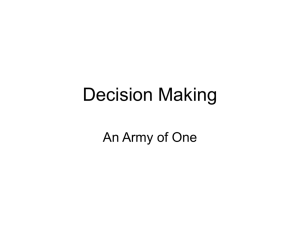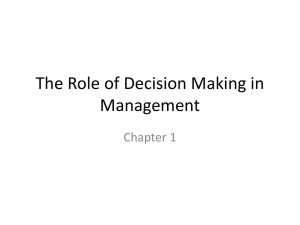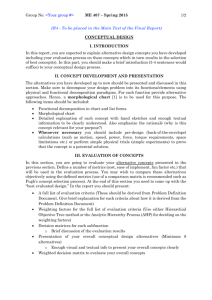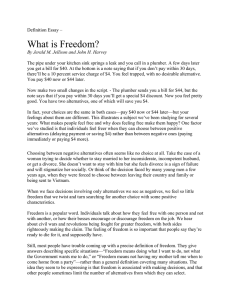LECTURE 29
advertisement
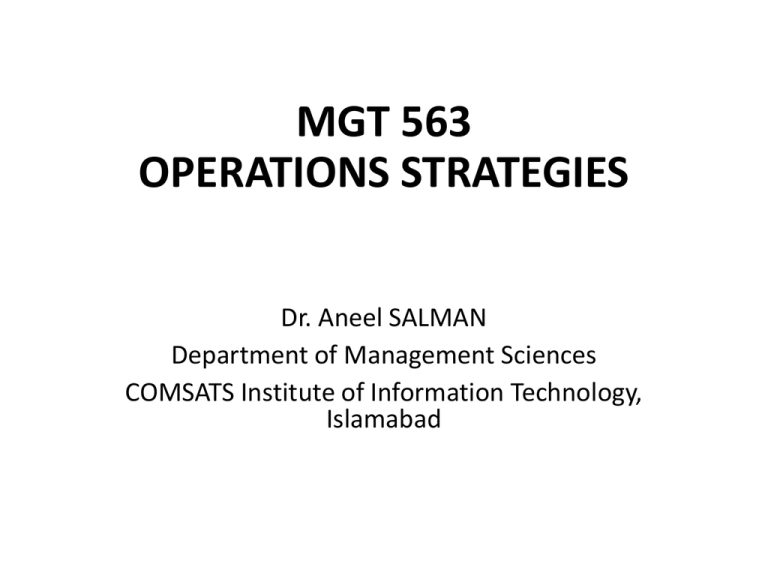
MGT 563 OPERATIONS STRATEGIES Dr. Aneel SALMAN Department of Management Sciences COMSATS Institute of Information Technology, Islamabad Recap Lecture 28 • Strategic Human Resource Management Managerial Decision Making Programmed Decisions • Routine situations • Decision rules can be developed and applied • Managers formulate decision rules so subordinates can make decisions Nonprogrammed Decisions • • • • Poorly defined situations Decisions are complex Routine decision rules do not apply Trend is toward subordinates making more nonprogrammed decisions Degrees of Outcome Predictability • • • • Certainty Risk Uncertainty Ambiguity Certainty • Full knowledge of available alternatives • Full knowledge of what outcome will result from each alternative • Few certain decisions in the real world. Risk • Knowledge of what the alternatives are • Know the probabilities of outcomes resulting from each alternative. Uncertainty • Goals are known, but information about alternatives and future outcomes is incomplete (probabilities unknown) Ambiguity • Objectives to be achieved are unclear • Little, if any, knowledge of alternatives Classical Model 1. Goals are known and agreed upon. Problems are precisely defined 2. All alternatives and outcomes are calculated 3. Criteria evaluated and decision made maximizing return (expected value) 4. Uses rationality and logic. Classical Model Assumes: • Knowledge of Persons and Environ. • Stability of Persons and Environment • Memory and Reasoning Capabilities • Absence of Emotion • Resources (Time & Money) Administrative Model • Describes how managers actually make decisions including those that are: – Nonprogrammed – Uncertain – Ambiguous – Not Quantitative • Used due to “Bounded Rationality” Bounded Rationality People have limits on the information they can process in making a decision, so their use of rationality is limited. Satisficing • (Satisfactory + Sacrifice) • Choosing the first alternative satisfying minimum decision criteria (i.e., the optimal solution is often not needed) • Often cannot afford time and expense of complete information, even if possible. Intuition • Based on years of practice and hands-on experience (i.e., not naive guessing) • Facilitates Satisficing Decision Making Steps • • • • • • Recognition of Decision Requirement Diagnosis and Analysis of Causes Development of Alternatives Selection of Desired Alternative Implementation of Chosen Alternative Evaluation and Feedback. Comments on Decision Making Steps • The Classical Model focuses on the Selection of Desired Alternative • Nonprogrammed problems require more attention to the earlier steps. • Evaluation and Feedback can lead to reverting back to any prior stage to make a correction. Personal Decision Framework Situation: · Programmed/non-programmed · Classical, administrative, political · Decision steps Personal Decision Style: ·Directive ·Analytical ·Conceptual ·Behavioral Decision Choice: ·Solution to Problem Directive Style: used by people who prefer simple, clear-cut solutions. They are efficient and rational. Analytical Style: used by managers who like to consider complex solutions based on as much data as they can gather. They are objective and rational and like optimal solutions. Conceptual Style: used by people who like to consider a broad amount of information, and are more creative and socially oriented. They consult with others for information and ideas. Behavioral Style: often the style adopted by managers having a deep concern for others. They consult with others to determine the feelings of the others. Decision Styles • Differences among people with respect to how they perceive problems and make decisions • Not all managers make decisions the same – Directive style – Analytical style – Conceptual style – Behavioral style 20 Personal Decision Framework Situation: · Programmed/nonprogrammed · Classical, administrative, political · Decision steps 21 Personal Decision Style: ·Directive ·Analytical ·Conceptual ·Behavioral Decision Choice: ·Best Solution to Problem Directive Style • People who prefer simple, clear-cut solutions to problems • Make decisions quickly • May consider only one or two alternatives • Efficient and rational • Prefer rules or procedures 22 Analytical Style • Complex solutions based on as much data as they can gather • Carefully consider alternatives • Base decision on objective, rational data from management control systems and other sources • Search for best possible decision based on information available 23 Conceptual Style • Consider a broad amount of information • More socially oriented than analytical style • Like to talk to others about the problem and possible solutions • Consider many broad alternatives • Relay on information from people and systems • Solve problems creatively 24 Behavioral Style • Have a deep concern for others as individuals • Like to talk to people one-on-one • Understand their feelings about the problem and the effect of a given decision upon them • Concerned with the personal development of others • May make decisions to help others achieve their goals 25 Participation in Decision Making Vroom-Jago Model • Helps gauge the appropriate amount of participation for subordinates in process • Leader Participation Styles • Five levels of subordinate participation in decision making ranging from highly autocratic to highly democratic 26 Participation in Decision Making Vroom-Jago Model • Diagnostic Questions • Decision participation depends on the responses to seven diagnostic questions about – the problem – the required level of decision quality – the importance of having subordinates commit to the decision 27 Seven Leader Diagnostic Questions How significant is the decision? How important is subordinate commitment? What is the level of the leader’s expertise? If the leader were to make the decision alone at what level would subordinates be committed to the decision? What level is the subordinate’s support for the team or organization’s objectives? What is the member’s level of knowledge or expertise relative to the problem? How skilled or committed are group members to working together? 28 New Decision Approaches for Turbulent Times New Decision Approaches for Turbulent Times 29 Advantages of Group Decision Making • • • • • More background knowledge More alternatives generated More understanding of the decision More support for decision Helps fulfill social needs Disadvantages of Group Decision Making • • • • Time consuming, inefficient Ineffective Compromise decisions Groupthink, social pressure, conflict Lack of clear responsibility Conditions for Groupthink • • • • Team leader’s opinion is known Team is highly cohesive Team is isolated from outside influences Team has recent decision failures Escalation of Commitment British government funded the Concorde supersonic jet long after its lack of commercial viability was apparent. Today, some scholars refer to escalation of commitment, in general, as the “Concorde Fallacy.” © Corel Corp. With permission Causes of Escalation of Commitment • Ego Defense • Sunk Costs • Gambler’s Fallacy © Corel Corp. With permission An Interactive Group Members meet face-to-face and have a specific agenda and decision objectives. (the “typical” meeting) Improving Interactive Groups • To Combat “Groupthink”: – Devil's Advocate – Multiple Advocacy – Dialectic Inquiry Improving Interactive Groups • Brainstorming Improving Interactive Groups • Brainstorming – More ideas – “Synergy” Alternatives to Interactive Groups • Nominal Groups – Ideas in writing before discussion to help equalize participation • Delphi Groups – No face-to-face interaction - even more equal participation Improving Decision-Making Effectiveness • Learn from past decisions, but don’t waste time regretting past • Distinguish between idea getting and evaluating (Don’t be too critical when generating ideas.) • Seek advice, when practical • As a group leader, don’t dominate the discussion • When possible, “sleep on” decisions, but don’t wait too long.
